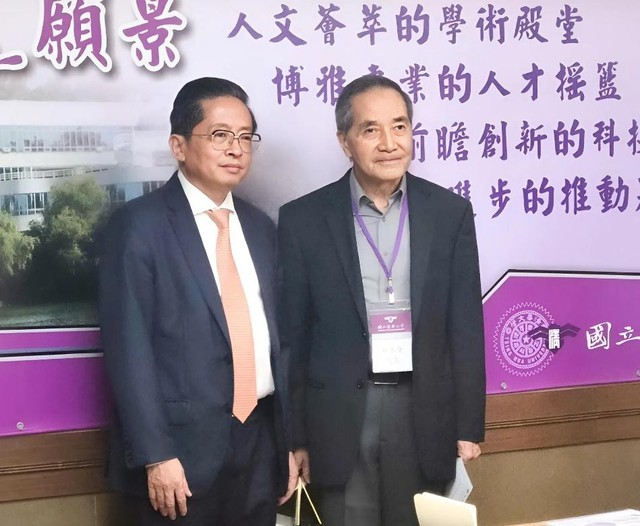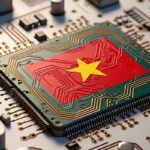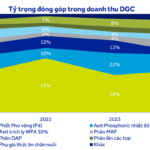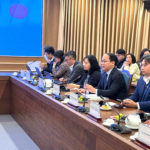Pioneer of Immersion Lithography: The Story of Professor Burn-Jeng Lin
Not many in the semiconductor industry are familiar with the academic and research journey of Professor Burn-Jeng Lin, the man who revolutionized global microcircuitry. Born in 1942 in Cho Lon, Ho Chi Minh City, Vietnam, Professor Lin’s passion for science took him to Taiwan where he studied electrical engineering at National Taiwan University before obtaining his doctorate from Ohio State University in the United States.

Professor Burn-Jeng Lin (right) and Mr. Tran Kim Chung, Chairman of CT Group (left)
For 18 years, from 1975 to 1993, Professor Lin was a key researcher at the renowned IBM Thomas J. Watson Research Center, a hub of brilliant minds in microcircuitry. There, he played a pivotal role in developing advanced lithography technologies, particularly the concept of immersion lithography.
In the early 2000s, as chip manufacturing faced physical limitations due to shrinking transistor sizes, Professor Lin proposed a revolutionary idea. He suggested using an ultra-pure water layer between the lens and the wafer to increase optical refraction, thereby improving resolution and enabling the creation of higher-density chips. Despite initial skepticism from industry giants like Intel, IBM, and AMD, TSMC, with its strategic vision, became the first company to embrace, invest in, and industrialize this technique.
The results were game-changing. TSMC became the world’s first contract chip manufacturer to successfully apply immersion lithography, ushering in a new generation of chips with higher transistor density, superior performance, and lower energy consumption. This breakthrough not only helped TSMC surpass its longstanding competitors but also solidified its global leadership in advanced chip manufacturing.
Professor Lin was intimately involved in the technology transfer, research, and engineering teams’ training to ensure the successful implementation of this novel solution at TSMC. With over 60 international patents to his name, he has been recognized as an IEEE Fellow and a member of the National Academy of Engineering in the United States.
Shaping the Future: The Legacy of a Visionary
After his time in the United States, Professor Lin’s deepest affiliation was with National Tsing Hua University in Taiwan, a prestigious academic hub in the region. Founded in 1956 in Hsinchu City, the university is a strategic training and research center for science and engineering, particularly renowned for its high-tech programs in microelectronics and semiconductors.
Strategically located in the Hsinchu Science Park, often referred to as the “Silicon Valley of Asia,” the university fosters a strong connection between academia and industry. It provides not only theoretical foundations but also stays abreast of the latest manufacturing practices and R&D advancements from leading technology corporations such as TSMC, UMC, ASE, MediaTek, and numerous other multinational semiconductor companies.
The university’s School of Semiconductor Research, where Professor Lin served as the director, is a pioneer in training engineers and conducting in-depth research on chip manufacturing technologies, SoC design, EUV lithography, MEMS, packaging, and other advanced fields. Professor Lin was not just a leading scientist but also a mentor who shaped the curriculum, guided interdisciplinary collaborations, and defined the strategic direction of the entire department.
The combination of a rigorous research culture and continuous innovation has established National Tsing Hua University as a leading microcircuitry hub in Asia. Professor Lin’s legacy encompasses not just technical innovations but also a generation of well-trained semiconductor engineers who are shaping the future of the global semiconductor industry.
The Ultimate Guide to Dominating the Global Export Market: Unveiling the Secrets of Vietnam’s Success in the Highly Lucrative Industry
As the leading manufacturer of these products, we boast the largest design capacity in Vietnam. Our state-of-the-art facilities and expert team ensure we remain at the forefront of the industry. With a relentless focus on innovation and quality, we strive to deliver exceptional products that meet the needs of our customers. Our commitment to staying ahead of the curve has solidified our position as the top player in the market.
How to Leverage the Power of Rare Earth Elements?
Dr. Ha Ton Vinh, a Senior Advisor to the World Bank, asserts that Vietnam holds a strategic advantage in rare earth resources, which could serve as a bargaining chip in negotiations pertaining to tariff and trade disputes.





















